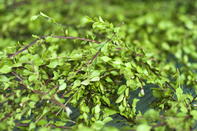Buchu, a fragrant fynbos shrub commonly found in the Cape Floral Kingdom of the Western Cape, has been used for centuries for its medicinal value.

Agathosma, the genus name of the range of buchu plants, is derived from the Greek words agathos (‘good’) and osme (‘fragrance’) and refers to the small aromatic leaves of these plants. When picked or crushed, the tiny leaves with oil glands on the undersides, exude a smell reminiscent of black currant and rosemary.
The genus Agathosma (Rutaceae) consists of approximately 150 species indigenous to South Africa but two specifically are endemic to the Western Cape - Agathosma betulina (‘round-leaf buchu’) and Agathosma crenulata (‘oval-leaf buchu’). A. betulina is most commonly used in commercial applications such as the extraction of buchu oil.
Traditionally, buchu has been used to treat all kinds of ailments including colds and flu symptoms, inflammation, as a diuretic (to treat kidney and urinary tract infections) but also as a stomach tonic.
Leaves were chewed fresh, or poultices for arthritis-ridden limbs were made with the crushed leaves, but more convenient for modern consumers, buchu tea is made of the dried leaves and is now available in tea bags. Loose buchu leaves (one to two teaspoons) can be infused in a cup of boiling water.
Buchu is also available as buchu water, buchu essential oil and steeped in brandy and vinegar. Medicinal forms of buchu include buchu first-aid gel, salves and capsules.
In bulk form, buchu leaves are in 15 kg sealed bulk bags. Cut leaves (for tea) and buchu powder are packed in 5 kg or 10 kg bags.
By Marinda Louw
For bulk or export enquiries please use the enquiry link below.